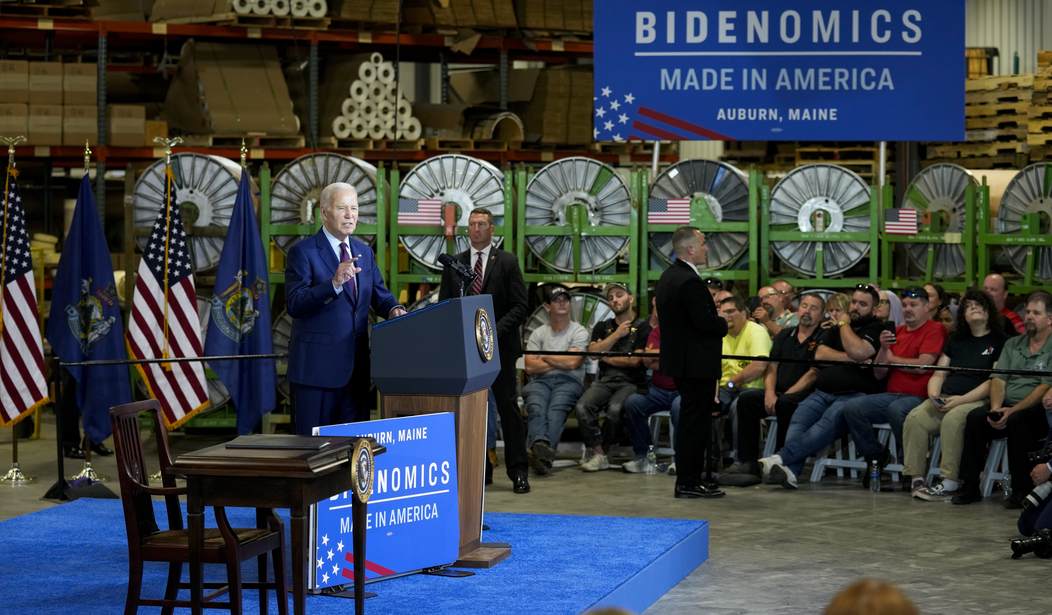After 12 straight months of the inflation rate coming down, prices rose in July — .02% over the price rise in June and 3.2% over prices from a year ago.
“We’ve made this progress while maintaining the broad strength of our economy,” Biden said in a statement, noting that unemployment remained near 50-year lows.
“I’m sure they’ll find something,” Biden joked during a speech in New Mexico, referring to GOP criticisms of “Bidenomics.”
Where do you want us to start, Joe?
How about housing?
From the fourth quarter of 2020 to the fourth quarter of 2022, the U.S. housing market experienced one of the most significant increases in housing prices in American history. Data provided by the Federal Reserve Bank of St. Louis show that over that two-year period, the average sales price of a home skyrocketed more than 36 percent, from $403,900 to a whopping $552,600.
For the first time in history, the 12-month increase in home prices topped 15 percent for seven quarters in a row, beginning in the second quarter of 2021.
Many current homeowners celebrated the unprecedented rise in housing values, but those rapid increases came with an important caveat: whenever housing prices increase as quickly as they have in recent years, an economic, stock market, and/or housing crash is almost certain to follow.
Then there’s the rest of the consumer price index, still making life miserable for most Americans.
The food index rose 0.2%, the energy index rose 0.1%, the fuel oil index rose 3%, the utility (piped) gas service index rose 2%, and the shelter index rose 0.4%, while the energy services index decreased 0.1%, the electricity index decreased 0.7%, the used cars and trucks index decreased 1.3%, and the medical care services index decreased 0.4%, according to the U.S. Bureau of Labor Statistics.
Biden doesn’t drive his own car much, so he probably hasn’t noticed that gas prices are on the rise again. Gas is up 8% since July 1.
According to eToro global market strategist Ben Laidler, the move in gas prices from $3.09 in December 2022 to the national average price on Monday at $3.83 is an extra annual cost of roughly $101 billion for US consumers in total (based on the estimate that Americans use roughly 375 million gallons of gas each day).
With where gas prices stand — and they should remain elevated — that means consumers have less money to spend elsewhere, such as discretionary purchases.
The last time gas prices surged, Biden decided to draw down the Strategic Petroleum Reserve by about 300 million barrels. Biden won’t have that fallback reserve if prices spike again — something that could very well happen given OPEC+ and their desire to squeeze the West. The cartel has finally got Saudi Arabia on board for steep production cuts, and The Kingdom doesn’t appear ready to do the West any favors and boost output anytime soon.
Alfredo Ortiz, chief executive officer and president of Job Creators Network, said in a Thursday statement, “This accelerating inflation shows the inflation fight is far from over, no matter what Democrats and the media say.”
“The Fed’s historic interest rate hikes have caused significant problems for small businesses and dramatically reduced their access to credit, but they haven’t been enough to overcome the Biden administration’s reckless spending and anti-energy policies responsible for persistent Bidenflation,” he added.
Talk of “recession” has faded among the moneymen and high priests of finance on Wall Street. But 60% of Americans still give Joe Biden terrible marks on the economy. As American kids head back to school, the economic outlook is forcing parents to rein in their spending as they take a wait-and-see attitude toward the future.










Join the conversation as a VIP Member